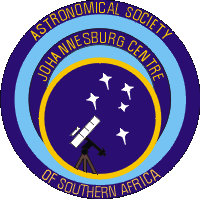 |
About us |
 |
About us |
Thank you for your interest in the Johannesburg Centre of the Astronomical Society of Southern Africa. We are a group of enthusiasts who come from all walks of life and share a common interest in Astronomy, an interest that may be deep and intense or slight and casual – we welcome and cater for all. Whatever aspect of astronomy turns you on – be it that you are there purely to appreciate the beauty of the cosmos, wish to contribute to the advancement of science, enjoy tinkering with gadgets, want to talk about cosmology, or whatever else – we have a place for you. Some of us own telescopes, some binoculars and some only a pair of sharp eyes with which to view the heavens. As with several similar centres scattered in and around South Africa, the Johannesburg Centre is independent of but affiliated to the Astronomical Society of Southern Africa.
We hold a monthly general meeting at 20h00 on the 2nd Wednesday of each month (except December). Our normal venue is the Sir Herbert Baker Library Building on the site of the old Union Observatory. The address is 18A Gill Street., Observatory, Johannesburg – entrance is via Innes St. These meetings usually take the form of a lecture by a guest speaker, a debate or a film show, with refreshments and socialising afterwards. Public viewing evenings are (weather permitting) held at the Observatory on the Friday closest to New Moon, starting at about 20h00. The Centre’s monthly newsletter "Canopus" - which is also available via the Internet - provides full details of these meetings. The general public is particularly encouraged to come to both the general meetings and the viewing evenings: meet us, look through the Centre’s telescopes and find out more.
Why join?Membership of the Centre confers several benefits. Not least of these is the opportunity to have contact with friendly, knowledgeable individuals who share your interests in astronomy. We freely impart our knowledge, ideas, enthusiasm, advice and experience. We encourage you to do likewise. As a member, you would have access to our facilities, including a library dedicated to astronomy and related disciplines. Successful completion a simple "driver’s course" will allow you the use of our instruments. Apart from this, you get to participate in our other events and activities. Our ties to the Planetarium are also advantageous. Have you just purchased a telescope? We can help you to learn to set it up and use it. Are you thinking of purchasing one? We can help you make the right choice. Want to know what’s up there? Need to discuss your theories? We are here!
ActivitiesApart from the activities already mentioned above, our members - according to their individual needs and interests - are involved in a variety of activities including the following…
Participation in scientifically valuable observations – amateur astronomers can and do provide input to professional programs. Surprisingly, many of these need only simple equipment such as binoculars (or even the naked eye!) to accomplish. Examples of exciting and fulfilling programs in which our members are active include:
Telescope making classes are conducted on an ongoing basis. With the application of some effort and a really modest outlay in cash, you too can build a fully functional telescope that will keep you happily observing for years to come. A large number of instruments have been completed under our guidance over the last several years. These range from the basic and plain to the sophisticated, beautiful and even computer-controlled: the sky is literally the limit. By building it yourself, you can not only save substantial sums of money, but also tailor-make the instrument to your own specific needs. The satisfaction of fashioning an optical surface to an accuracy of a few millionths of an inch with your bare hands is matched only by the pride of accomplishment when you stand back to survey your personal creation and the enjoyment of observing with something you have built yourself. The first glimpse of the heavens through your own home-built telescope is truly a thrilling experience without parallel.
Group activities and excursions are periodically arranged. These range from informal gatherings for deep-sky viewing at dark sites, through visits to observatories, impact craters and other places of scientific interest, to meteorite hunting and even eclipse viewing expeditions. We take advantage of circumstances such as visiting scientific luminaries or astronomical events such as meteor showers and the appearance of comets to hold extra-ordinary meetings, viewing sessions and gatherings. Courses in constellation recognition, basic astronomy, use of instruments and so on are offered whenever there is sufficient demand. There are also purely social activities, exemplified by the end-of-year "solstice party".
Photographic and Electronic Imaging is a field of endeavour that - while it can certainly begin with humble and inexpensive equipment needs - generally attracts those looking for a challenge. Some of our members have even built their own specialist astronomical cameras and tracking platforms dedicated to the task.
Why not involve yourself in contributing to our newsletter? Researching areas of interest to you and putting them forth for others to enjoy is a fulfilling and educational experience.
Enquiries / visits / to become a member? For further information, please …(18A Gill Street, Observatory, Johannesburg), or…
(phone [011] 717-1392 during office hours), or…
You may also download and fill in the attached application form then send it with the appropriate joining and subscription fees to the secretary at:-
P.O.Box 93145,
Yeoville,
2143
...or bring it along to one our monthly meetings and hand it in, in person.
For those who are already members, you may download the current Subscription Renewal form here, then send it with the appropriate subscription fees to the secretary to renew your membership.